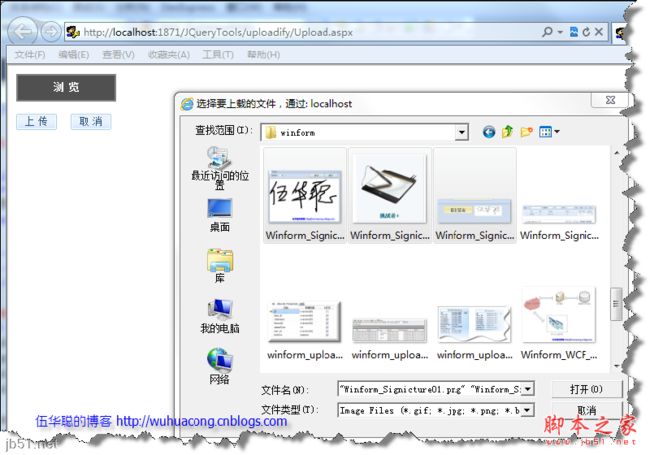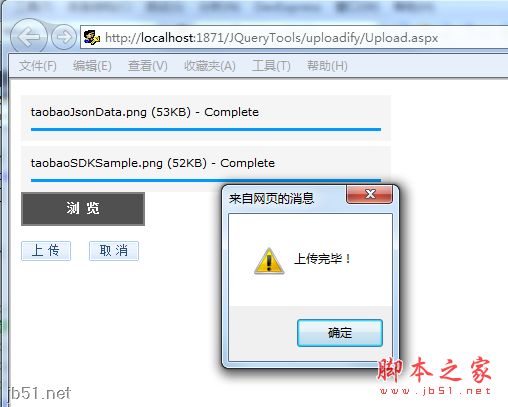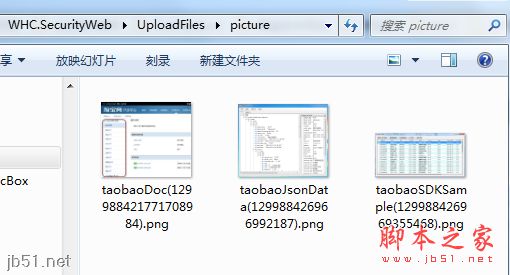在Web开发中,有很多可以上传的组件模块,利用HTML的File控件的上传也是一种办法,不过这种方式,需要处理的细节比较多,而且只能支持单文件的操作。在目前Web开发中用的比较多的,可能uploadify(参考http://www.uploadify.com/)也算一个吧,不过这个版本一直在变化,他们的脚本调用也有很大的不同,甚至调用及参数都一直在变化,很早的时候,那个Flash的按钮文字还没法变化,本篇随笔主要根据项目实际,介绍一下3.1版本的uploadify的控件使用,这版本目前还是最新的,因此对我们做Web开发来说,有一定的参考性。
这个控件有很多参数控制,以及事件的处理响应,相对来说也比较好用。参数控制可以控制上传文件多选、文件类型、文件大小、文件数量、检查文件是否存在,以及一些按钮参数的控制,如文字、高度、宽度等,对提交文件成功与否、完成操作、取消、停止上传等等都有控制,他们的帮助文档也写得比较完善,不过就是各个版本的方法参数完全不同了,但控件是一个好控件。
控件的使用首先要加入必备的脚本类库,由于该控件是利用了Jquery的功能,因此还需要应用Jquery脚本文件,如下所示。
配置控件的一些参数,以及相应的处理事件,如下所示。
再次提一下,这个控件不要参考网上其他的一些说明,否则可能参数及用法不正确,一定要找到对应版本的说明(本篇指的是3.1.1),最好参考该版本的在线文档。
上面的参数,我基本上都给了注释了,还有一些不是很重要的参数,这里没有列出来,需要可以参考在线文档吧。
值得提到的是,这个版本可以修改Flash里面的文字,非常棒,很讨厌以前的那个默认Browse的英文,虽然以前替代图片可以修改文字,但是还是不太好用。这个直接修改文字,非常好。
值得注意的是uploader参数,这个是我们ashx的后台处理程序,就是控件提交文件给那个页面进行保存处理,添加数据库记录等操作。
页面代码使用很简单,如下所示
关键是后台上传文件的保存操作了,asp.net一般采用ashx的处理页面来处理。
///
/// 文件上传后台处理页面
///
[WebService(Namespace = "http://tempuri.org/")]
[WebServiceBinding(ConformsTo = WsiProfiles.BasicProfile1_1)]
public class UploadHandler : IHttpHandler
{
public void ProcessRequest(HttpContext context)
{
context.Response.ContentType = "text/plain";
context.Response.Charset = "utf-8";
try
{
string guid = context.Request.QueryString["guid"];
string folder = context.Request["folder"];
//LogTextHelper.Info(folder);
HttpPostedFile file = context.Request.Files["Filedata"];
if (file != null)
{
string oldFileName = file.FileName;//原文件名
int size = file.ContentLength;//附件大小
string extenstion = oldFileName.Substring(oldFileName.LastIndexOf(".") + 1);//后缀名
string newFileName = GetNewFileName(oldFileName);//生成新文件名
//LogTextHelper.Info(newFileName);
#region 上传到远程服务器
//FileServerManage fsw = new FileServerManage();
//string uploadFilePath = "/" + newFileName;
//if (!string.IsNullOrEmpty(folder))
//{
// uploadFilePath = string.Format("/{0}/{1}", folder, newFileName);
//}
//bool uploaded = fsw.UploadFile(file.InputStream, "/" + folder + "/" + newFileName);
#endregion
#region 本地服务器上传
AppConfig config = new AppConfig();
string uploadFiles = config.AppConfigGet("uploadFiles");
if (string.IsNullOrEmpty(uploadFiles))
{
uploadFiles = "uploadFiles";
}
if (!string.IsNullOrEmpty(folder))
{
uploadFiles = Path.Combine(uploadFiles, folder);
}
string uploadPath = Path.Combine(HttpContext.Current.Server.MapPath("/"), uploadFiles);
if (!Directory.Exists(uploadPath))
{
Directory.CreateDirectory(uploadPath);
}
string newFilePath = Path.Combine(uploadPath, newFileName);
LogTextHelper.Info(newFilePath);
file.SaveAs(newFilePath);
bool uploaded = File.Exists(newFilePath);
#endregion
if (uploaded)
{
#region 文件保存成功后,写入附件的数据库记录
//AttachmentInfo attachmentInfo = new AttachmentInfo();
//attachmentInfo.EditorTime = DateTime.Now;
//attachmentInfo.FileExtend = extenstion;
//attachmentInfo.FileName = folader + "/" + newFileName;
//attachmentInfo.OldFileName = oldFileName;
//attachmentInfo.Size = size;
//attachmentInfo.Guid = guid;
//BLLFactory
#endregion
}
}
else
{
LogTextHelper.Error("上传文件失败");
}
}
catch (Exception ex)
{
LogTextHelper.Error("上传文件失败", ex);
throw;
}
}
///
/// 获取新的名称 比如:aa.jpg转化为aa(20090504).jpg
///
/// 文件名称[aa.jpg]
///
public static string GetNewFileName(string fileName)
{
if (string.IsNullOrEmpty(fileName))
return string.Empty;
//文件后缀名
string extenstion = fileName.Substring(fileName.LastIndexOf(".") + 1);
string name = fileName.Substring(0, fileName.LastIndexOf(".")) + "(" + DateTime.Now.ToFileTime() + ")";
string newFileName = name + "." + extenstion;
return newFileName;
}
public bool IsReusable
{
get
{
return false;
}
}
}


